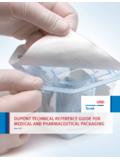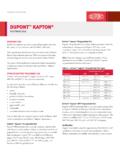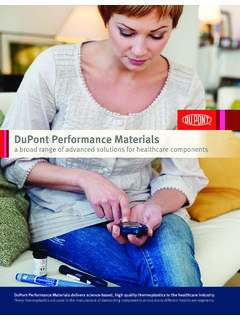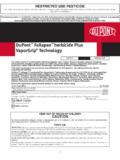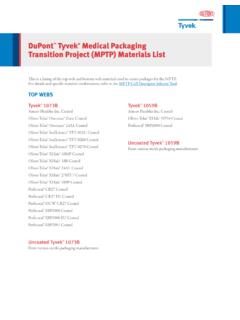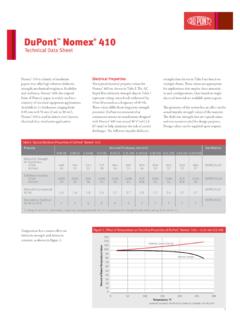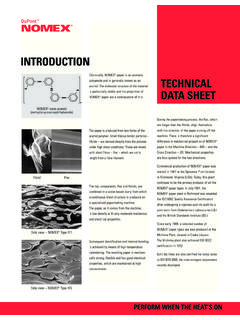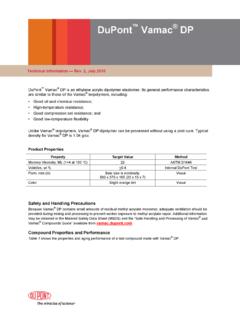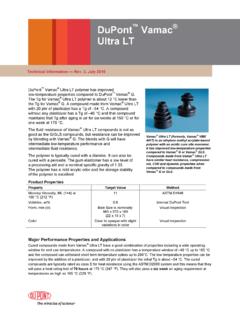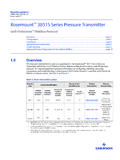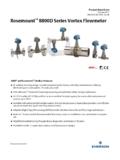Transcription of Printed Circuit Materials Riston and Stouffer Density Tablets
1 Technical Data m DuPont Photopolymer & Electronic Materials Printed Circuit Materials Riston and Stouffer Density Tablets Photopolymer Film Technical Bulletin TB-9526. DESCRIPTION. The Riston 25-Step Density Tablet (step tablet) is a strip of MYLAR polyester film containing 25 OPTICAL Density : numbered blocks (steps) of increasing optical den- PERCENT LIGHT TRANSMITTED. sity. It is used to measure the degree of polymeriza- tion of DuPont Riston photopolymer films from 90%. exposure to ultraviolet (UV) light in the imaging step 80%.
2 70%. of Printed wiring board manufacture. 60%. 50%. 40%. Optical Density (OD) is the term used to relate the 30%. amount of light transmitted through a phototool to 20%. the amount of light it receives. It is a logarithmic 10%. function: 0%. 0 1 2 3. OPTICAL Density . % Transmitted Incident light intensity (I). OD = Log 10 [ ]. Transmitted light intensity (T). or OD = Log 10 (I) - Log 10 (T). Step Tablets are made so that each step increases in optical Density by a specific amount. As the step number increases, the amount of UV light passing The graph below shows the percent light transmitted through each step decreases.
3 At a given exposure as a function of optical Density . energy there will be a step where not enough light passes through the step tablet to polymerize the photoresist. Therefore, the step tablet is used as a measure of the total amount of light that the photore- sist receives during exposure. TB-9526 (07/98) Rev. 1. TABLE I There are several different types of step Tablets and STEP TABLET RELATIONSHIPS. each has a different optical Density range. Table I, "Step Tablet Relationships, shows the relationship Optical DuPont Stouffer Stouffer Stouffer of optical Density to the DuPont 25 Step Tablet, the Density 25 Step Tab.
4 21 Step Tab. 31 Step Tab. 41 Step Tab. Stouffer 21 Step Tablet and the Stouffer 41 Step 1 Tablet. 1 1. 2 2. 3 RULES OF THUMB: 2 3 4 To compare the Stouffer 41 Step to Riston 25. 5. 4 6 Step add 9 to the Riston Step. For example, a 3 7 Riston Step 14 is equal to a Stouffer 41 of 23 (14. 5 8 + 9). 9. 1 4 6 10 To compare the Riston 25 step to the Stouffer 21. 2 11 step, multiply the Stouffer step by 3 and subtract 3 7 12 11. For example, a Stouffer step 8 is equal to a 4 5 13 Riston step 13 [(3 x 8)-11]. 5 8 14. 6 15. 7 6 9 16.
5 8 17. 9 10 18 HOW TO USE THE 25-STEP. 10 7 19. 11. 12. 11 20. 21. Density TABLET. 13 8 12 22 PROCESSING TEST PANELS. 14 23 1. Laminate test panels with Riston film. Prepare 15 13 24. 16 9 25. test panels in the same manner as the production 17 14 26 panels. 18 27. 19 10 15 28. 20 29. 2. Set the photoprinter (exposure unit) for the time 21 16 30 or integrator setting that should give the energy 22 11 31 required for the photoresist used. 23 17 32. 24 33. 25 12 18 34 3. Place the production phototool on a test panel. 35 Place the step tablet over a clear area of the 19 36 phototool.
6 If a double-sided vacuum frame is 13 37. 20 38 used, check both sides with step Tablets . 39. 14 21 40 4. Expose and develop the panel. Use the same 41. 22 hold times that are used for production panels. 15. 23 5. After development, numbered blocks of resist 16 24 (steps) will be evident. 25 INTERPRETING STEPS HELD. 17. 26 Unless the panel was drastically overexposed, the photoresist will have been completely removed 18 27 from the highest numbered steps. The photoresist remaining on several of the high number steps may 28.
7 19. be wrinkled or partially removed. The "step held". 29 is the highest number step which is more than 50%. covered with photoresist. 20 30. 31. 21. TB-9526 (07/98) Rev. 2. It is not necessary to take pains to interpret the step are for use with the Riston 25 or Stouffer 41 Step held. If you are uncertain whether more than 50% Tablets . For the Stouffer 21 tablet, use the equation remains at a particular step, assume it does not since above. the 25-Step Density Tablet is very sensitive, and most Riston films have a broad exposure latitude Table 2.
8 Operating range. Exposure Adjustment Factors Note the following points to obtain consistent, Difference in Steps Factor reliable results with the DuPont 25-Step Density 1 Tablet: 2 3 4 Do not place the step tablet under the phototool. 5 6 This lifts the phototool from the resist, causing 7 off-contact printing, affecting the width of Circuit 8 lines and spaces. 9 10 Small changes in developer temperature, as well as changes in development time or breakpoint, may change the steps held. Conditions must be kept reasonably constant to assure reproducible EXAMPLES USING THE EXPOSURE ADJUSTMENT.
9 Results. FACTORS. The recommended minimum hold times after TO INCREASE STEPS HELD: lamination and exposure must be maintained. Multiply the exposure time or integrator counts by Hold times less than the minimum recommended the appropriate factor from Table 2. for the photoresist may cause fluctuations in step tablet results. For Example: Time - A 15 second test exposure produces 5 steps EXPOSURE ADJUSTMENT held. If a step 8 is recommended, 3 more steps are required. Referring to Table 2, the factor is The desired exposure time, exposure energy, or integrator counts needed to expose to a desired step Multiply the test exposure time by the factor (15.)
10 Can be determined with good accuracy. The calcula- secs x = secs). An exposure of about 21. tion is different for the Riston 25 Step and the seconds should result in 8 steps held. Stouffer 41 Step Tablets compared to the Stouffer 21. Step Tablet. The equation for the Riston 25 and integrator Counts - A test exposure with an Stouffer 41 Step Tablets is: integrator setting of 80 produces 5 steps held. If a step 8 is recommended, 3 more steps are required. Referring to Table 2, the factor is Multiply Desired time, energy or counts =.
